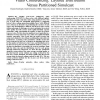Free Online Productivity Tools
i2Speak
i2Symbol
i2OCR
iTex2Img
iWeb2Print
iWeb2Shot
i2Type
iPdf2Split
iPdf2Merge
i2Bopomofo
i2Arabic
i2Style
i2Image
i2PDF
iLatex2Rtf
Sci2ools
TMM
2016
2016
Dealing With User Heterogeneity in P2P Multi-Party Video Conferencing: Layered Distribution Versus Partitioned Simulcast
—We consider peer-to-peer multi-party video conferencing (P2P-MPVC), where users with different uplinkdownlink capacities send their videos using multicast trees. One way to deal with user bandwidth heterogeneity is employing layered video coding, generating multiple layers with different rates, whereas an alternative is partitioning the receivers of each source and disseminating a different non-layered video version within each group. In this paper, we aim to maximize the received video quality for both systems under uplink-downlink capacity constraints, while constraining the number of hops the packets traverse to two. We first show any multicast tree is equivalent to a collection of 1-hop and 2-hop trees, under user uplink-downlink capacity constraints. This reveals that the packet overlay hop count can be limited to two without sacrificing the achievable rate performance. Assuming a fine granularity scalable stream that can be truncated at any rate, we propose an algorithm tha...
TMM 2016 |
| Added | 11 Apr 2016 |
| Updated | 11 Apr 2016 |
| Type | Journal |
| Year | 2016 |
| Where | TMM |
| Authors | Eymen Kurdoglu, Yong Liu, Yao Wang |
Comments (0)

